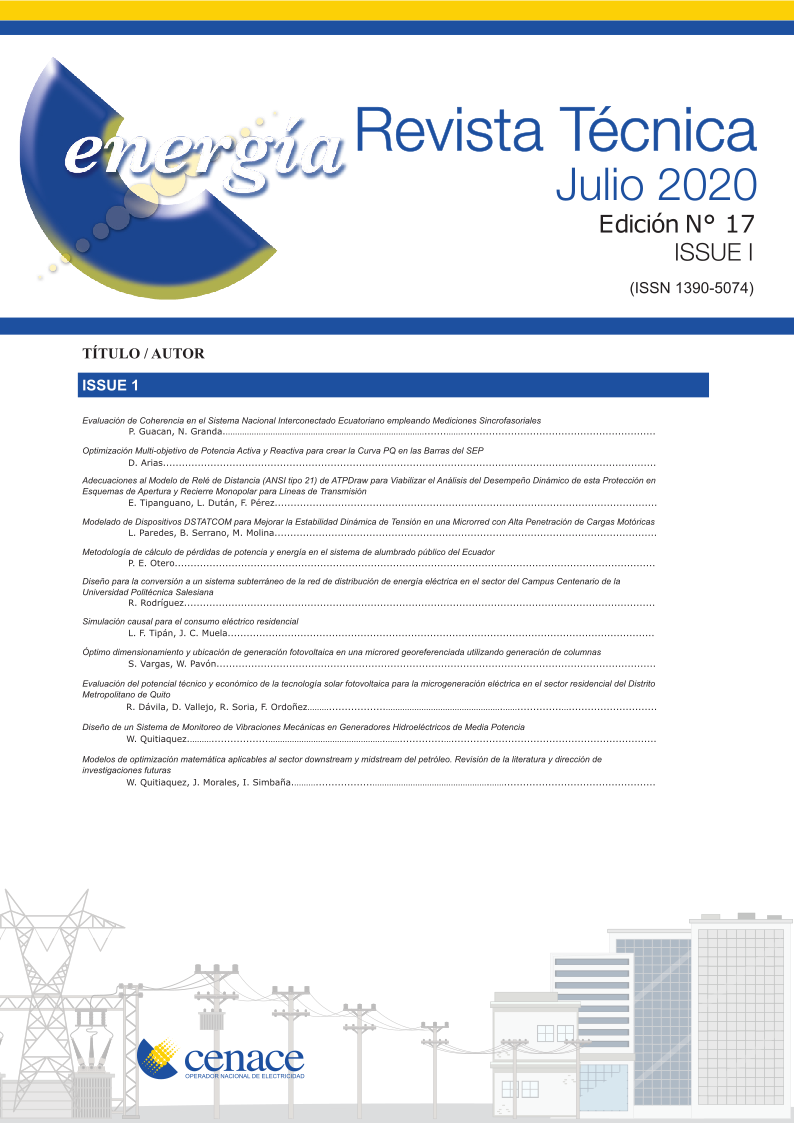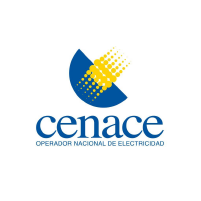Modeling of DSTATCOM Devices to Improve Dynamic Voltage Stability in a Microgrid with High Penetration of Motor Loads
Modeling of DSTATCOM Devices to Improve Dynamic Voltage Stability in a Microgrid with High Penetration of Motor Loads
Cómo citar
Descargar cita
Mostrar biografía de los autores
Artículos similares
- Graciela Colomé, Omar Ramos, Diego Echeverría, Metodología de Identificación de Modos Oscilatorios en Datos Tipo Ambiente de Mediciones PMU , Revista Técnica "energía": Vol. 21 Núm. 1 (2024): Revista Técnica "energía", Edición No. 21, ISSUE I
- Isaac Simbaña, Sarai Mena, Silvana Chasipanta, Análisis de la Eficiencia Energética en un Horno Eléctrico con la Implementación de un Ventilador Convectivo , Revista Técnica "energía": Vol. 22 Núm. 1 (2025): Revista Técnica "energía", Edición No. 22, ISSUE I
- Andrés Jacho, Diego Echeverría, Santiago Chamba, Carlos Lozada, Wilson Sánchez, Aplicación del Control Formador de Red en Microrredes con Sistemas de Almacenamiento de Energía para la Regulación Primaria de Frecuencia, Caso de Estudio: Islas Galápagos , Revista Técnica "energía": Vol. 21 Núm. 1 (2024): Revista Técnica "energía", Edición No. 21, ISSUE I
- William Quitiaquez, Hugo Meneses, Patricio Quitiaquez, Isaac Simbaña, Regeneración de Componentes Deteriorados de Motores de Combustión Interna Utilizados en Centrales Térmicas , Revista Técnica "energía": Vol. 21 Núm. 2 (2025): Revista Técnica "energía", Edición No. 21, ISSUE II
- Isaac Simbaña, William Quitiaquez, Patricio Cabezas, Patricio Quitiaquez, Estudio comparativo de la eficiencia de colectores solares de placa plana rectangular y triangular mediante el método de elementos finitos , Revista Técnica "energía": Vol. 20 Núm. 2 (2024): Revista Técnica "energía", Edición No. 20, ISSUE II
- Daniel Orbe, Luis Salazar, Paúl Vásquez, Estimación y Análisis de Sensibilidad del Consumo Energético de Buses Eléctricos mediante Simulaciones Microscópicas en líneas de Transporte Público , Revista Técnica "energía": Vol. 21 Núm. 1 (2024): Revista Técnica "energía", Edición No. 21, ISSUE I
- Johnny Heredia, Edy Ayala , Diseño de Sistema para la Generación de Mantenimiento Predictivo Basado en IoT e Inteligencia Artificial para Talleres de Mecánica Exprés , Revista Técnica "energía": Vol. 21 Núm. 2 (2025): Revista Técnica "energía", Edición No. 21, ISSUE II
- Kleber Zhañay, Cristian Leiva, Erika Pilataxi, William Quitiaquez, Modelo de Correlación Desgaste - Cantidad de Sedimentos para la Programación de Mantenimiento Preventivo de una central Hidroeléctrica , Revista Técnica "energía": Vol. 21 Núm. 2 (2025): Revista Técnica "energía", Edición No. 21, ISSUE II
- Alex Mullo, José Reinoso, Marlon Chamba, Carlos Lozada, Análisis y Caracterización de la Calidad de Energía utilizando Minería de Datos , Revista Técnica "energía": Vol. 22 Núm. 1 (2025): Revista Técnica "energía", Edición No. 22, ISSUE I
- Josue Ortiz, Jefferson Tayupanda, Carlos Quinatoa, Solución al problema de despacho hidrotérmico a corto plazo mediante la programación no lineal aplicada a sistemas de uno y varios nodos , Revista Técnica "energía": Vol. 20 Núm. 2 (2024): Revista Técnica "energía", Edición No. 20, ISSUE II
También puede Iniciar una búsqueda de similitud avanzada para este artículo.
Artículos más leídos del mismo autor/a
- Luis Paredes, Marcelo Pozo, Movilidad Eléctrica y Eficiencia Energética en el Sistema de Transporte Público del Ecuador un Mecanismo para Reducir Emisiones de CO2 , Revista Técnica "energía": Vol. 16 Núm. 2 (2020): Revista Técnica "energía", Edición No. 16
- Luis Paredes, Benjamín Serrano, Marcelo Molina , Mejoramiento de la Estabilidad de Tensión con un DSTATCOM en una Microrred Integrada por GD Solar Fotovoltaica y Convencional , Revista Técnica "energía": Vol. 16 Núm. 2 (2020): Revista Técnica "energía", Edición No. 16
A través de este artículo se propone y valida modelos de dispositivos de tecnología FACTS de tipo Compensador Estático Sincrónico para Distribución (DSTATCOM). En primera instancia, se presenta el modelado de un DSTATCOM simplificado realizado a través de una fuente de corriente controlada. Posteriormente, se expone un DSTATCOM modelado a través de estrategias de control considerando un conversor PWM (Pulse-Width Modulation - Modulación por ancho de pulsos). Los modelos propuestos de dispositivos DSTATCOM se validan en un sistema de prueba de Microrred Eléctrica (MRE) de la CIGRÉ. La presencia de cargas de tipo motor de inducción en la MRE requiere una considerable demanda de potencia reactiva, esto ocasiona inconvenientes para mantener la Estabilidad Dinámica de Tensión (EDT). Ésta situación se agrava ante la ocurrencia de fallas que desencadenen una operación aislada de la MRE. Para solucionar estos inconvenientes se hará uso de un dispositivo DSTATCOM. La conexión y ubicación óptima del DSTATCOM en la MRE se realiza a través de un algoritmo de búsqueda exhaustiva, considerando la premisa del mejor rendimiento en términos de EDT realizado a través de simulaciones dinámicas en PowerFactory DIgSILENT. Comparativamente se presentan los resultados obtenidos para los dos modelos realizados, demostrándose la mejora de la EDT en la operación aislada de la MRE con ambos modelos. Dependiendo del detalle y alcance de los estudios en el sistema de MRE, se puede elegir entre los modelos DSTATCOM desarrollados. Todos los detalles de modelos, esquemas de control y datos de los dispositivos DSTATCOM son proporcionados en este documento.
Visitas del artículo 858 | Visitas PDF 395
Descargas
[1] N. Mahdavi, S. Najafi, and N. Bizon, Power Systems Resilience. 2019.
[2] L. A. Paredes, B. R. Serrano, and M. G. Molina, “Microgrids ─ a Methodological Review in the Current Context of Electric Systems,” CIEEPI - Rev. del Col. Ing. Eléctricos y Electrónicos Pichincha, no. 49, 2019.
[3] K. P. Schneider, F. K. Tuffner, M. A. Elizondo, C. C. Liu, Y. Xu, and D. Ton, “Evaluating the Feasibility to Use Microgrids as a Resiliency Resource,” IEEE Trans. Smart Grid, vol. 8, no. 2, pp. 687–696, 2017.
[4] D. E. Olivares et al., “Trends in microgrid control,” IEEE Trans. Smart Grid, vol. 5, no. 4, pp. 1905–1919, 2014.
[5] J. Guerrero et al., “Distributed generation: Toward a new energy paradigm,” IEEE Ind. Electron. Mag., vol. 4, no. 1, pp. 52–64, 2010.
[6] L. A. Paredes, B. R. Serrano, and M. G. Molina, “Energy Management in Isolated Microgrids of the Ecuadorian Amazon Region,” in 3er Simposio Ibero-Americano en Microrredes Inteligentes con Integración de Energías Renovables, 2019.
[7] F. Katiraei, M. R. Iravani, and P. W. Lehn, “Micro-grid autonomous operation during and subsequent to islanding process,” IEEE Trans. Power Deliv., vol. 20, no. 1, pp. 248–257, 2005.
[8] IEEE PES Industry Technical Support Task Force, “Impact of IEEE 1547 Standard on Smart Inverters,” 2018.
[9] A. Khadem Abbasi, M. W. B. Muatafa, and A. S. B. Mokhtar, “Small signal stability analysis of rectifier-inverter fed induction motor drive for microgrid applications,” IEEE Reg. 10 Annu. Int. Conf. Proceedings/TENCON, pp. 1015–1019, 2011.
[10] D. Wu, H. Wu, and H. Dongt, “Influence of induction motor starting on microgrid,” Asia-Pacific Power Energy Eng. Conf. APPEEC, vol. 2018-Octob, pp. 376–381, 2018.
[11] N. Afrin, F. Yang, J. Lu, and M. Islam, “Impact of induction motor load on the dynamic voltage stability of microgrid,” ANZCC 2018 - 2018 Aust. New Zeal. Control Conf., pp. 397–402, 2018.
[12] W. Freitas, A. Morelato, W. Xu, and F. Sato, “Impacts of AC generators and DSTATCOM devices on the dynamic performance of distribution systems,” IEEE Trans. Power Deliv., vol. 20, no. 2 II, pp. 1493–1501, 2005.
[13] T. Samad and A. M. Annaswamy, “Controls for Smart Grids: Architectures and Applications,” Proc. IEEE, vol. 105, no. 11, pp. 2244–2261, 2017.
[14] L. A. Paredes, B. R. Serrano, and M. G. Molina, “Nuevo Paradigma de los Sistemas Eléctricos: Generación Distribuida y Microrredes Eléctricas un Vínculo de Accesibilidad a la Electricidad en América Latina y el Caribe,” ENERLAC, vol. 3, 2020.
[15] M. S. Mahmoud and F. M. AL-Sunni, Control and Optimization of Distributed Generation Systems. 2015.
[16] G. B. Gharehpetian and S. M. M. Agah, Distributed Generation Systems: Design, Opearation and Grid Integration. 2017.
[17] E. A. Tapia, J. D. Pinzón, and D. G. Colomé, “Load Dynamic Impact on Short-Term Voltage Stability,” in 2019 FISE-IEEE/CIGRE Conference - Living the energy Transition (FISE/CIGRE), 2019.
[18] A. A. Edris et al., “Proposed terms and definitions for Flexible AC Transmission System (FACTS),” IEEE Trans. Power Deliv., vol. 12, no. 4, pp. 1848–1853, 1997.
[19] L. Gyugyi, R. A. Otto, and T. H. Putman, “Principles and applications of static, thyristor-controlled shunt compensators,” IEEE Trans. Power Appar. Syst., vol. PAS-97, no. 5, pp. 1935–1945, 1978.
[20] N. G. Hingoranl, L. Gyugyi, and M. E. El-Hawary, Understanding FACTS: Concepts and technology of flexible ac transmission systems. 1999.
[21] L. A. Paredes, B. R. Serrano, and M. G. Molina, “FACTS Technology to Improve the Operation of Resilient Microgrids,” in 2019 FISE-IEEE/CIGRE Conference - Living the Energy Transition (FISE/CIGRE), 2019, pp. 1–7.
[22] F. M. Gonzalez-Longatt and J. L. Rueda, PowerFactory Aplications for Power System Analysis. Springer, 2014.
[23] S. Houbing, S. Ravi, S. Tmim, and J. Sabina, Smart Cities, no. 10. Wiley, 2017.
[24] L. A. Paredes, B. R. Serrano, and M. G. Molina, “Voltage Stability Improvement with a DSTATCOM in a Microgrid Integrated by DG Solar Photovoltaic and Conventional,” Rev. Técnica “energía,” vol. 16, no. II, 2020.
[25] R. B. Prada, “Voltage stability and thermal limit: Constraints on the maximum loading of electrical energy distribution feeders,” IEE Proc. - Gener. Transm. Distrib., vol. 145, no. ii, pp. 573–577, 1998.
[26] P. Coelho, M. Gomes, and C. Moreira, Microgrids Design and Implementation. 2019.
[27] Y. Xu, C.-C. Liu, K. Schneider, F. Tuffner, and D. Ton, “Microgrids for Service Restoration to Critical Load in a Resilient Distribution System,” IEEE Trans. Smart Grid, vol. 9, no. 1, pp. 1–1, 2016.
[28] J. Hossain and H. R. Pota, Robust Control for Grid Voltage Stability: High Penetration of Renewable Energy. 2014.






















